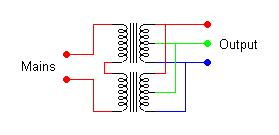I ask as I have a variety of toroidal transformers... two of which came from a "killed" ML No27 amp. But, they all have much higher supply voltages.
I have two toroids, from an old Optonica amp, at +/- 45. The MLs seem to be about +/- 65.
I thought about building DC-DC converters to use them but to create one to handle the dissipation of a BA-2 might be insane.
Or, maybe a Pass design is not what I need...
I have two toroids, from an old Optonica amp, at +/- 45. The MLs seem to be about +/- 65.
I thought about building DC-DC converters to use them but to create one to handle the dissipation of a BA-2 might be insane.
Or, maybe a Pass design is not what I need...
If they have separate secondaries (e.g. two times 0-45 windings instead of one 45-0-45), you can connect the secondaries in parallel to make a single-ended supply.
Or... desperate last resort:
Use two transformers together, with the primaries connected in series and the secondaries in parallel. They don't even have to be the same. e.g. With a 45V transformer and a 65V transformer, the voltages work out like this:
45v xformer:
primary voltage: 120*65/(65+45)=70.91V
secondary voltage: 45*70.91/120=26.6V
65v xformer:
primary voltage: 120*45/(65+45)=49.09V
secondary voltage: 65*49.09/120=26.6V
Heheh - I'm starting to like this idea. It sounds like you have enough to make a pair of monoblock amps, each with two power transformers.
Or... desperate last resort:
Use two transformers together, with the primaries connected in series and the secondaries in parallel. They don't even have to be the same. e.g. With a 45V transformer and a 65V transformer, the voltages work out like this:
45v xformer:
primary voltage: 120*65/(65+45)=70.91V
secondary voltage: 45*70.91/120=26.6V
65v xformer:
primary voltage: 120*45/(65+45)=49.09V
secondary voltage: 65*49.09/120=26.6V
Heheh - I'm starting to like this idea. It sounds like you have enough to make a pair of monoblock amps, each with two power transformers.
Attachments
I like that idea as well. But, there is a massive difference between the 45v and 65v transformers. The 45v are like 8 pounds and the 65v is more like 25 pounds.
Also, I am not too sure on the wiring diagram for the ML ones. They must have peeled the original manufacturer labels off of them and the voltage readings are not really making sense. Unless, I have two primary, CT'ed windings. But, when I connected what I though was the second primary it did not work at all.
If anything, I can sell these and buy the proper transformers for BA-2. However, I am having a tough time finding those as well. I am in a pretty good transformer rut today.
Also, I am not too sure on the wiring diagram for the ML ones. They must have peeled the original manufacturer labels off of them and the voltage readings are not really making sense. Unless, I have two primary, CT'ed windings. But, when I connected what I though was the second primary it did not work at all.
If anything, I can sell these and buy the proper transformers for BA-2. However, I am having a tough time finding those as well. I am in a pretty good transformer rut today.
Or... desperate last resort:
Use two transformers together, with the primaries connected in series and the secondaries in parallel. They don't even have to be the same. e.g. With a 45V transformer and a 65V transformer, the voltages work out like this:
45v xformer:
primary voltage: 120*65/(65+45)=70.91V
secondary voltage: 45*70.91/120=26.6V
65v xformer:
primary voltage: 120*45/(65+45)=49.09V
secondary voltage: 65*49.09/120=26.6V
It's still a bit early in the day for me, but why does this work? (since it seems to open up many possibilities for my transformer collection)
The way I see it... If you force the secondaries to be the same voltage (by connecting them in parallel), then the primary voltages must be different, so the mains voltage is shared unequally between the two primaries.
edit: Just make sure you get the phase right or you'll be boosting the primary voltage on one or both of the trannies to higher than mains voltage.
edit: Just make sure you get the phase right or you'll be boosting the primary voltage on one or both of the trannies to higher than mains voltage.
Last edited:
- Status
- This old topic is closed. If you want to reopen this topic, contact a moderator using the "Report Post" button.
- Home
- Amplifiers
- Pass Labs
- Any Pass amps use a higher supply voltage?
